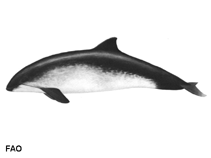Phocoena phocoena (Linnaeus, 1758)
Harbour porpoise| Native range | All suitable habitat | Point map | Year 2050 |

|
| This map was computer-generated and has not yet been reviewed. |
| Phocoena phocoena AquaMaps Data sources: GBIF OBIS |
Classification / Names Common names | Synonyms | CoL | ITIS | WoRMS
Mammalia | Cetartiodactyla | Phocoenidae
Environment: milieu / climate zone / depth range / distribution range Ecology
Pelagic; oceanodromous (Ref. 75906). Temperate; 2°C - 16°C (Ref. 75906); 90°N - 0°S, 180°W - 180°E
Distribution Countries | FAO areas | Ecosystems | Occurrences | Introductions
Mediterranean and Black Sea, Atlantic Ocean, Pacific Ocean and the Arctic: Phocoena phocoena phocoena: Baffin Island, Labrador, Newfoundland, Gulf of St. Lawrence, North Carolina, Greenland, Iceland, Faroes, Russia, Portugal, Baltic Sea [Baltic Sea population: IUCN 2010 (Ref. 84930): CR, C2a(ii).], Gulf of Finland, Gulf of Bosnia, British Isles, Tunisia, Spain, Morocco, Senegal; Phocoena phocoena relicta: Black Sea, Sea of Azov, Bosporus (Turkey), Sea of Marmara, northern Aegean Sea; Phocoena phocoena subsp.: Russia, Aleutian Islands (Alaska), Sea of Okhotsk, Japan, Bering Strait; Phocoena phocoena vomerina: Pribilof Islands, USA, Canada (Ref. 1522).
Length at first maturity / Size / Weight / Age
Maturity: Lm 145.0 range ? - ? cm Max length : 200 cm TL male/unsexed; (Ref. 1394); max. published weight: 70.0 kg (Ref. 1394)
Life cycle and mating behavior Maturity | Reproduction | Spawning | Eggs | Fecundity | Larvae
Main reference
References | Coordinator | Collaborators
Jefferson, T.A., S. Leatherwood and M.A. Webber 1993 FAO species Identification Guide: Marine Mammals of the World. Rome, FAO. 320 p. + 587 figures. (Ref. 1394)
IUCN Red List Status
(Ref. 130435: Version 2025-1)
CITES status (Ref. 108899)
CMS (Ref. 116361)
Threat to humans
Human uses
Fisheries: commercial
FAO - Fisheries: landings, species profile | FishSource | Sea Around Us
Tools
More information
Max. ages / sizes
Length-weight rel.
Length-length rel.
Length-frequencies
Mass conversion
Abundance
Internet sources
BHL | BOLD Systems | CISTI | DiscoverLife | FAO(Fisheries: species profile; publication : search) | Fishipedia | GenBank (genome, nucleotide) | GloBI | Gomexsi | Google Books | Google Scholar | Google | PubMed | Tree of Life | Wikipedia (Go, Search) | Zoological Record



